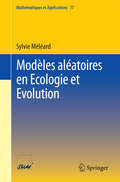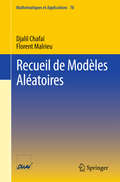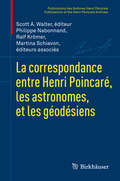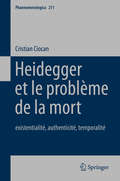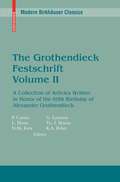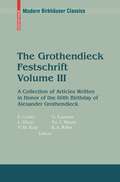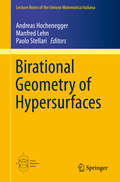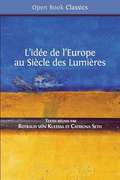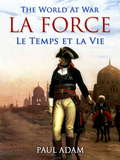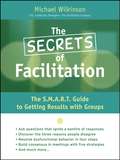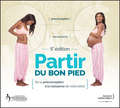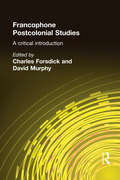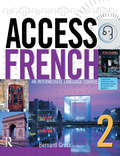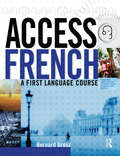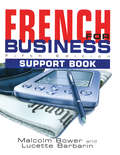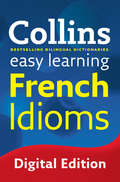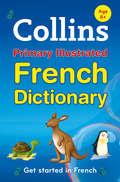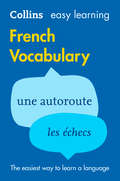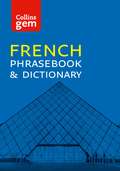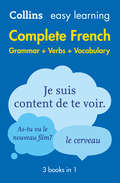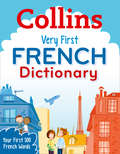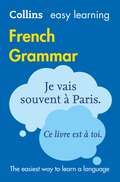- Table View
- List View
Modèles aléatoires en Ecologie et Evolution (Mathématiques et Applications #77)
by Sylvie MéléardLe but du livre est de définir et développer une grande gamme d'outils probabilistes pour la modélisation en biologie des populations, afin de décrire des dynamiques temporelles de quantités biologiques telles que la taille d'une ou plusieurs populations, la proportion d'un allèle dans une population ou la position d'un individu. En partant de modèles markoviens discrets (marches aléatoires, processus de Galton-Watson), nous abordons progressivement le calcul stochastique et les équations différentielles stochastiques, puis les processus markoviens de saut, tels les processus de branchement à temps continu et les processus de naissance et mort. Nous étudions également les processus discret et continu pour l'évolution génétique et les généalogies: processus de Wright-Fisher et coalescent. Le livre détaille systématiquement les calculs de quantités d'intérêt pour les biologistes. De nombreux exercices d'application sont proposés. Le dernier chapitre montre l'apport de ces outils pour des problématiques biologiques actuelles. Il développe en détail des travaux de recherche très récents. This book defines and develops probabilistic tools for the modeling of populations in order to describe the dynamics of biological quantities such as population size, allele proportion in a population and individual location. From discrete Markovian models (random walks, Galton-Watson processes), it gradually introduces the stochastic calculus and the stochastic differential equations, as well as the jump Markov processes, such as the branching processes in continuous time and the birth and death processes. It also discusses the discrete and continuous processes of genetic evolution, genealogies and the Wright-Fisher processes and coalescent. The book systematically details the computation of quantities of interest to biologists and provides a number of exercises. The last chapter shows the use of probabilistic tools for real-world biological problems, and discusses recent research in detail.
Recueil de Modèles Aléatoires (Mathématiques et Applications #78)
by Djalil Chafaï Florent MalrieuCe recueil puise sa source dans les cours de master de mathématiques appliquées et de préparation à l’épreuve de modélisation de l’agrégation de mathématiques. Le parti pris de cet ouvrage est de polariser la rédaction par les modèles plutôt que par les outils, et de consacrer chaque chapitre à un modèle. Le premier public visé est celui des enseignants-chercheurs en probabilités, débutants ou confirmés. De nombreux chapitres peuvent également bénéficier directement à des étudiants de master ou préparant l’agrégation.This collection was inspired by applied mathematics Master classes in stochastic modeling. The focus is on models rather than on tools, and each chapter is devoted to a specific model. Though the book is primarily intended for academics in the field of probability theory, beginners and experienced researchers alike, many chapters will also benefit students preparing to pursue their Master degree in mathematics.
La correspondance entre Henri Poincaré, les astronomes, et les géodésiens (Publications des Archives Henri Poincaré Publications of the Henri Poincaré Archives)
by Scott Walter Ralf Krömer Philippe Nabonnand Martina SchiavonThe letters in this volume cover Poincaré's multifaceted career in astronomy in its entirety, extending from the time of his first publications in 1880 to the end of his life in 1912. At a tender age, Poincaré established his authority in questions of celestial mechanics, and his views were soon sought after on a vast array of questions by the leading astronomers and geodesists of his time, including C.V.L. Charlier, G.H. Darwin, H. Faye, F.R. Helmert, G. W. Hill, A. Lindstedt, A.M. Liapunov, N. Lockyer, S. Newcomb, K. Schwarzschild, and F. Tisserand. Poincaré and his correspondents take up topics ranging from the three-body problem and perturbation theory to the determination of the geoide and the equilibrium figures of rotating fluid masses. The volume also sheds light on Poincaré's three terms as president of the Bureau of Longitudes, where he guided French astronomy and geodesy through ambitious projects, such as the measurement of an arc of meridian near Quito.------Les lettres du troisième volume de la Correspondance de Poincaré scandent toute son œuvre astronomique, allant de ses premiers mémoires sur les courbes définies par une équation différentielle (1881), jusqu'aux analyses des hypothèses cosmogoniques (1911). Encore très jeune, Poincaré s'est fait remarquer pour sa maîtrise des questions de la mécanique céleste, de tel sorte que les astronomes et les géodésiens l'ont souvent interpellé, y compris O. Callandreau, C.V.L. Charlier, G.H. Darwin, F.R. Helmert, A. Lindstedt, A.M. Lyapunov, Simon Newcomb, Karl Schwarzschild et F. Tisserand.Avec ses correspondants, Poincaré abordaient les questions principales de l'astronomie mathématique, du célèbre problème des trois corps à la théorie des perturbations et aux figures d'équilibre des masses fluides en rotation. La correspondance de Poincaré éditée et annotée dans ce volume concerne, au-delà des mémoires mathématiques, l'activité de Poincaré en tant que Professeur d'astronomie mathématique et de mécanique céleste à la Sorbonne, rédacteur en chef duBulletin astronomique, et membre du Bureau des longitudes, que Poincaré a présidé à trois reprises. Sa correspondance illumine, dans ce dernier cadre, la réalisation de la mesure d'un arc de méridien à Quito, et le règlement d'un différend franco-brittanique à propos de la différence de longitude entre Greenwich et Paris.
Heidegger et le problème de la mort: existentialité, authenticité, temporalité (Phaenomenologica #211)
by Cristian CiocanCet ouvrage est la première monographie systématique d’expression française dédiée exclusivement au problème heideggérien de la mort. Il se donne pour tâche de clarifier tout l’enjeu de cette question capitale de la pensée de Martin Heidegger. La nouveauté de cette étude réside dans une approche systématique et précise de Sein und Zeit, à partir d’une clarification rigoureuse de la notion d’Existenzial, en interprétant le problème de la mort dans l’articulation des structures fondamentales de l’être du Dasein. Cette approche permet non seulement d’expliciter les différentes couches ontologiques où intervient le phénomène de la mort dans l’analytique existentiale, mais aussi de mettre en lumière la rigueur de l’analyse heideggérienne et la systématicité de sa démarche. En outre, cette investigation explore l’intégralité de la pensée de Heidegger : des écrits de jeunesse jusqu’aux textes les plus tardifs, l’ouvrage retrace non seulement la genèse complexe de cette question, mais aussi son évolution arborescente.
The Grothendieck Festschrift, Volume II: A Collection of Articles Written in Honor of the 60th Birthday of Alexander Grothendieck (Modern Birkhäuser Classics Ser.)
by Nicholas M. Katz Yuri I. Manin A. Grothendieck P. Cartier Luc Illusie Gérard Laumon Kenneth A. RibetThis three-volume work contains articles collected on the occasion of Alexander Grothendieck’s sixtieth birthday and originally published in 1990. The articles were offered as a tribute to one of the world’s greatest living mathematicians. Many of the groundbreaking contributions in these volumes contain material that is now considered foundational to the subject. Topics addressed by these top-notch contributors match the breadth of Grothendieck’s own interests, including: functional analysis, algebraic geometry, algebraic topology, number theory, representation theory, K-theory, category theory, and homological algebra.
The Grothendieck Festschrift, Volume III: A Collection of Articles Written in Honor of the 60th Birthday of Alexander Grothendieck (Modern Birkhäuser Classics Ser. #88)
by A. Grothendieck P. Cartier L. Illusie N. M. Katz G. Laumon Yu. I. Manin K. A. RibetThis three-volume work contains articles collected on the occasion of Alexander Grothendieck’s sixtieth birthday and originally published in 1990. The articles were offered as a tribute to one of the world’s greatest living mathematicians. Many of the groundbreaking contributions in these volumes contain material that is now considered foundational to the subject. Topics addressed by these top-notch contributors match the breadth of Grothendieck’s own interests, including: functional analysis, algebraic geometry, algebraic topology, number theory, representation theory, K-theory, category theory, and homological algebra.
The Red Countess: Select Autobiographical and Fictional Writing of Hermynia Zur Mühlen (1883-1951)
by Hermynia Mühlen Lionel GossmanBorn into a distinguished aristocratic family of the old Habsburg Empire, Hermynia Zur Mühlen spent much of her childhood and early youth travelling in Europe and North Africa with her diplomat father. Never comfortable with the traditional roles women were expected to play, she broke as a young adult both with her family and, after five years on his estate in the old Czarist Russia, with her German Junker husband, and set out as an independent, free-thinking individual, earning a precarious living as a writer. She translated over 70 books from English, French and Russian into German, notably the novels of Upton Sinclair, which she turned into best-sellers in Germany; produced a series of detective novels under a pseudonym; wrote seven engaging and thought-provoking novels of her own, six of which were translated into English; contributed countless insightful short stories and articles to newspapers and magazines; and, having become a committed socialist, achieved international renown in the 1920s with her Fairy Tales for Workers’ Children, which were widely translated including into Chinese and Japanese. Because of her fervent and outspoken opposition to National Socialism, she and her life-long Jewish partner, Stefan Klein, had to flee first Germany, where they had settled, and then, in 1938, her native Austria. They found refuge in England, where Zur Mühlen died, forgotten and virtually penniless, in 1951. This new, expanded edition contains: Zur Mühlen’s autobiographical memoir, The End and the Beginning; The editor’s detailed notes on the persons and events mentioned in the autobiography; A selection of Zur Mühlen’s short stories and two fairy tales; A synopsis of Zur Mühlen’s untranslated novel Our Daughters the Nazi Girls; An essay by the Editor on Zur Mühlen’s life and work; A bibliography of Zur Mühlen’s novels in English translation; A portfolio of selected illustrations of her work by George Grosz and Heinrich Vogeler; A free online supplement with additional original material
Yeats's Mask - Yeats Annual No. 19
by Margaret Harper Warwick GouldYeats’s Mask, Yeats Annual No. 19 is a special issue in this renowned research-level series. Fashionable in the age of Wilde, the Mask changes shape until it emerges as Mask in the system of A Vision. Chronologically tracing the concept through Yeats’s plays and those poems written as ‘texts for exposition’ of his occult thought which flowers in A Vision itself (1925 and 1937), the volume also spotlights ‘The Mask before The Mask’ numerous plays including Cathleen Ni-Houlihan, The King’s Threshold, Calvary, The Words upon the Window-pane, A Full Moon in March and The Death of Cuchulain. There are excurses into studies of Yeats’s friendship with the Oxford don and cleric, William Force Stead, his radio broadcasts, the Chinese contexts for his writing of ‘Lapis Lazuli’. His self-renewal after The Oxford Book of Modern Verse, and the key occult epistolary exchange ‘Leo Africanus’, edited from MSS by Steve L. Adams and George Mills Harper, is republished from the elusive Yeats Annual No. 1 (1982). The essays are by David Bradshaw, Michael Cade-Stewart, Aisling Carlin, Warwick Gould, Margaret Mills Harper, Pierre Longuenesse, Jerusha McCormack, Neil Mann, Emilie Morin, Elizabeth Müller and Alexandra Poulain, with shorter notes by Philip Bishop and Colin Smythe considering Yeats’s quatrain upon remaking himself and the pirate editions of The Land of Heart’s Desire. Ten reviews focus on various volumes of the Cornell Yeats MSS Series, his correspondence with George Yeats, and numerous critical studies. Yeats Annual is published by Open Book Publishers in association with the Institute of English Studies, University of London.
Birational Geometry of Hypersurfaces: Gargnano del Garda, Italy, 2018 (Lecture Notes of the Unione Matematica Italiana #26)
by Andreas Hochenegger Manfred Lehn Paolo StellariOriginating from the School on Birational Geometry of Hypersurfaces, this volume focuses on the notion of (stable) rationality of projective varieties and, more specifically, hypersurfaces in projective spaces, and provides a large number of open questions, techniques and spectacular results. The aim of the school was to shed light on this vast area of research by concentrating on two main aspects: (1) Approaches focusing on (stable) rationality using deformation theory and Chow-theoretic tools like decomposition of the diagonal; (2) The connection between K3 surfaces, hyperkähler geometry and cubic fourfolds, which has both a Hodge-theoretic and a homological side. Featuring the beautiful lectures given at the school by Jean-Louis Colliot-Thélène, Daniel Huybrechts, Emanuele Macrì, and Claire Voisin, the volume also includes additional notes by János Kollár and an appendix by Andreas Hochenegger.
L’idée de l’Europe au Siècle des Lumières (PDF)
by Rotraud Von Kulessa Catriona SethFace aux défis – entre autres politiques – auxquels sont confrontés différents pays européens, les chercheurs dix-huitiémistes ont souhaité revenir sur des expressions anciennes de valeurs partagées et les interrogations passées sur des questions qui restent souvent d’actualité. Au Siècle des Lumières, nombre d’hommes et de femmes de lettres ont envisagé l’avenir du continent en particulier pour entériner leur souhait de garantir la paix en Europe. Les textes, réunis dans cette anthologie, et signés des grands écrivains du temps (Rousseau, Montesquieu, Voltaire, Kant, Hume ou encore Staël), comme d’oubliés de l’histoire, présentent, avec quelques excursus chronologiques (de Sully à Hugo) les réflexions de penseurs d’un dix-huitième siècle aux bornes chronologiques étendues – l’émergence et la chute de l’Empire engendrent des bouleversements nombreux –, sur l’Europe, son histoire, sa diversité, mais aussi sur ce qu’ont en commun les nations qui composent, dans leur variété, un ensemble géographique. Ils mettent en évidence les origines historiques d’un projet d’union européenne, le souhait de consolider les liens du continent avec le Maghreb ou la Turquie, l’importance accordée au commerce et les inquiétudes suscitées par les sursauts de l’histoire, mais aussi l’espoir placé dans les générations futures. La Société française d’étude du XVIIIe siècle, l’Université d’Augsburg, l’Université d’Oxford ont généreusement contribué à la publication de ce volume. In view of the challenges—many of which are political—that different European countries are currently facing, scholars who work on the 18th century have compiled this anthology which includes earlier recognitions of common values and past considerations of questions which often remain pertinent nowadays. During the Enlightenment, many men and women of letters envisaged the continent’s future in particular when stressing their hope that peace could be secured in Europe. The texts gathered here, and signed by major thinkers of the time (Rousseau, Montesquieu, Voltaire, Kant, Hume or Staël for instance), as well as by writers history has forgotten, present the reflections, with a couple of chronological extensions (from Sully to Victor Hugo) of authors from the long eighteenth century—the French Empire and the fall of Napoleon generated numerous upheavals—on Europe, its history, its diversity, but also on what the nations, which, in all their diversity, make up a geographical unit, have in common. They show the historical origins of the project of a European union, the desire to consolidate the continent’s ties to the Maghreb or to Turkey, the importance granted to commerce and the worries engendered by history’s convulsions, but also the hope vested in future generations.
La Force / Le Temps et la Vie (The World At War)
by Paul AdamPaul Auguste Marie Adam1, né le 6 décembre 1862 à Paris où il est mort le 2 janvier 1920, est un écrivain français et critique d'art. Partisan du général Boulanger, il milite dans les mouvements nationalistes et traditionalistes et, pendant la Première Guerre mondiale, il se rend auprès des troupes pour soutenir leur moral et fonde la Ligue intellectuelle de fraternité latine. Parallèlement, il publie de très nombreux ouvrages : essais, romans, nouvelles, récits de voyage, parmi lesquels on peut citer les romans de son cycle napoléonien : La Force (1899), L'Enfant d'Austerlitz (1901), Au soleil de juillet (1903), ainsi que La Ruse (1903) et Stéphanie (1913). (Excerpt from Wikipedia)
The Secrets of Facilitation: The S.M.A.R.T. Guide to Getting Results With Groups
by Michael WilkinsonThe Secrets of Facilitation delivers a clear vision of facilitation excellence and reveals the specific techniques effective facilitators use to produce consistent, repeatable results with groups. Author Michael Wilkinson has trained thousands of managers, mediators, analysts, and consultants around the world to apply the power of SMART (Structured Meeting And Relating Techniques) facilitation to achieve amazing results with teams and task forces. He shows how anyone can use these proven group techniques in conflict resolution, consulting, managing, presenting, teaching, planning, selling, and other professional as well as personal situations.
Partir Du Bon Pied
by Nan Schuurmans Jennifer BlakeÉdition revue et mise à jour de LA ressource canadienne pour vivre une grossesse heureuse et en santé Partir du bon pied est votre guide pratique qui explique étape par étape ce à quoi vous devrez vous attendre dans la planification, la conception, le travail et dans tout ce qui touche la grossesse. Créée par la Société des obstétriciens et gynécologues du Canada (SOGC), cette ressource essentielle, qui en est à sa cinquième édition, contient les renseignements les plus récents pour vous aider à vivre une grossesse en santé. Dans ce guide écrit par les sommités canadiennes en matière de santé des mères et des nouveau-nés, les experts de la SOGC répondent à vos questions sur votre corps, votre bébé et votre vie durant la grossesse. La cinquième édition de cet incontournable regorge des renseignements les plus récents pour vous aider à démêler les faits des croyances. Pour que vous ayez une grossesse en santé, ce guide adopte une stratégie axée en grande partie sur la réduction des risques et met l'accent sur la période avant la conception du bébé et sur le début de la grossesse (les trois premiers mois après la conception). Grâce au guide Partir du bon pied, vous serez en mesure de faire les bons choix pour vous et votre bébé. Comme ce guide a été conçu dans un but pratique, vous pourrez l'utiliser comme cahier de note où inscrire tous les détails de votre grossesse, de vos suivis prénataux et de votre expérience d'accouchement. Le guide compte aussi un grand nombre de pages où vous pourrez écrire les informations importantes dont vous aurez besoin pendant la grossesse. Utilisez les espaces à la fin de chaque chapitre pour noter les questions à poser lors de votre prochain rendez-vous. Quand bébé sera sur le point de naître, vous pourrez consulter ce que nos experts ont à vous expliquer sur chacun des quatre stades de l'accouchement en plus de lire leurs conseils pour vous aider à vivre une expérience d'accouchement comme vous le souhaitez et à profiter des premiers moments avec votre nouveau-né. Une fois que vous serez mère, vous trouverez dans Partir du bon pied les conseils dont vous aurez besoin pour prendre soin de bébé et des renseignements entre autres sur les soins post-partum et l'allaitement.
Francophone Postcolonial Studies: A critical introduction (Francophone Postcolonial Studies #1)
by David Murphy Charles ForsdickThis landmark text constitutes the first comprehensive overview of Francophone Postcolonial Studies. Moving away from reductive geographical or linguistic surveys of the Francophone world, this collection of original essays provides a thematic discussion of the complex historical, political and cultural links between France and its former colonies. Providing a theoretical framework for postcolonial criticism of the field, it also aims to trigger a genuine dialogue between Francophone and Anglophone scholars of postcolonialism.Part I provides a historical overview, from the eighteenth to the twentieth century, addressing issues of colonialism, slavery and exoticism. Part II looks at language issues and discusses France's belief in the universality of its language and culture and the postcolonial challenges to that view. Part III discusses issues of diversity and multiculturalism in contemporary Francophone cultures. Part IV concludes with an analysis of the French-language contribution to postcolonialism as well as an examination of Francophone postcolonial thought and culture in the principal areas of the French-speaking world.Edited by two of the up-and-coming names in Francophone Postcolonial Studies, the collection includes contributions from an international team including some of the world's leading scholars in the field.
Access French 2: An Intermediate Language Course (BK)
by Bernard GroszAccess French 2 consolidates previous language skills, using the familiar framework of Language Focus panels, learning tips and assessment checklists. It looks at different topic areas in greater depth and goes on to cover more practical matters such as dealing with your finances, methods of communication, buying a property in France and the world of work. A wide range of activities based on realistic resources and situations affords plenty of opportunities for reading and writing authentic French, enabling learners to communicate at a higher level. Each of the 10 units begins with a variety of revision activities and there is frequent consolidation of important grammar points, giving learners the confidence to move forward. Units end with a Découverte de la Francophonie section exploring the customs and traditions of French-speaking countries.Access French 2 covers all the necessary topics, grammar and vocabulary for GCSE, LLAS OCR Intermediate Level (the new Language Ladder scheme) and Level 2 (National Language Standards).Students who have completed the course will have achieved the necessary entry requirements for AS and DELF level.
Access French: Student Book (Access Language Series)
by Bernard Grosz Henriette HarnischAccess is the major new language series designed with the needs of today's generation of students firmly in mind. Whether learning for leisure or business purposes or working towards a curriculum qualification, Access French is specially designed for adults of all ages and gives students a thorough grounding in all the skills required to understand, speak, read and write contemporary French from scratch.The coursebook consists of 10 units covering different topic areas, each of which includes Language Focus panels explaining the structures covered and a comprehensive glossary. Learning tips and assessment checklists help students to achieve a sense of autonomy while at the end of each unit, a Découverte de la Francophonie section presents short texts of cultural interest. Numerous references to web-based activities, which will be an invaluable support to students' learning, add significantly to the course. The accompanying free Website gives direct access to additional internet-based activities for students, plus teacher support and guidance.
French for Business: Students Book, 5th Edition (French For Business Ser.)
by Lucette Barbarin Malcolm BowerFirst published in 2002. Routledge is an imprint of Taylor & Francis, an informa company.
French for Business: Students Book, 5th Edition
by Lucette Barbarin Malcolm BowerFirst published in 2002. Routledge is an imprint of Taylor & Francis, an informa company.
Easy Learning French Idioms
by CollinsA unique guide to communicating in French. It will help learners discover expressions and idioms to make their French more natural and fluent, while developing an awareness of French culture.
Collins Primary Illustrated French Dictionary
by Collins DictionariesOptimised for colour tablets. The images in this e-book are not suitable for black and white e-ink devices.Collins Primary Illustrated French Dictionary is ideal for young learners of French as their first REAL dictionary. It offers detailed coverage of key French and English vocabulary in a highly attractive, colourful and easy-to-use format.
Easy Learning French Vocabulary
by Collins DictionariesThe quickest way to study the essential French words and the perfect companion to titles in the ever-popular Easy Learning French range.
Collins French Phrasebook and Dictionary Gem Edition: Phrasebook And Dictionary (Collins Gem #04)
by Collins DictionariesYou will never be lost for words in your travels around France again! Your ideal travel companion will ensure that you can say what you need in French with ease and confidence.
Easy Learning French Complete Grammar, Verbs and Vocabulary (3 books in 1)
by Collins DictionariesA handy 3-in-1 French study book: grammar, verbs and vocabulary in one volume, ideal for beginners who need a clear and easy-to-understand French reference and revision guide.
Collins Very First French Dictionary (Collins Primary Dictionaries)
by Collins DictionariesAn ideal first French dictionary for kids aged 5+ and above, designed to introduce French vocabulary to children in a fun, easy and memorable way.
Easy Learning French Grammar (Collins Easy Learning French Ser.)
by Collins DictionariesThis book offers beginners a clear and easy-to-understand guide to the verbs and grammar of French. Ideal for French revision.
